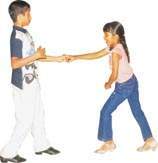| Mirror
Magazine |
||||||
|
Dance the night
away! Over the last decade an increasing number of people in Sri Lanka have taken up dancing either as a form of entertainment, pastime, stress reliever or just an 'enjoyable exercise'. "It is a controlled way of movement to music that is appreciated by everyone," says 'Footwork' Director Dharshan Wijesooriya, who also runs the Dance Academy in Green Path, Colombo. Latin American songs such as Ricky Martin's hits have also influenced the young generation, by sparking interest in standard Latin American dances. With so many learning to dance, is it indeed a necessary social skill? A favoured venue for many is the Dance Academy that holds classes at the Girls Friendly Society hall in Kollupitiya. The Academy promises to 'guide you through the wonders of ballroom and Latin American dancing'. You will find people from different professions ranging from students to doctors and businessmen there. "It is a relaxing atmosphere where I get to meet different people who also enjoy dancing," says dance enthusiast Stina Karlton from Sweden, who has been at the Academy for over a year. Courses are
offered for different levels of classes that teach the Jive, Cha
Cha, Waltz, Quickstep, Rhythm Dancing, Samba, Viennese Waltz, Tango,
and Rumba at a very " Everyone has an inherent interest in dancing regardless of their culture; it's a way of expressing themselves," says Senaka Saparamadu who along with his wife Nisha has attended these classes for three months. "Moreover when you are trained to do it properly, you can be more confident," they add. The monthly Sundown evening of the Dance Academy is much looked forward to by all participants as they can literally 'have a ball'. Experienced dancer/teacher Sriyan Senadhira says that each dance has a different meaning where facial expression is vital- the Jive with its energetic movements is for sheer enjoyment; the Rumba is more serious where eye contact is essential while the Tango, being more rigid, creates a more intense mood. "All these are good exercise," endorses Sriyan who is thrilled that he lost 24 lbs in three months by attending 2-3 hour dance classes 4-5 times a week! "Dancing is now considered a sport worldwide; it is not only for pleasure, as it requires stamina, exercise, dedication and hard work," comments Dharshan. "It's like learning to drive; you never forget how to do it," he adds. Currently he is the only Sri Lankan invited to judge international dance competitions with a distinguishing background of being a member and trainee of the National Association of Teachers of Dancing, in the United Kingdom. He is hopeful of having his team included in the 2008 Olympics to be held in China. "I get all kinds of people wanting to be trained including couples to be wed in a week," says Dharshan. For the mentally handicapped too, he adds, dancing is good therapy for it helps them focus and coordinate their movements better. Its also offers an excellent type of relaxation for those who have recovered from by pass surgery. Interestingly, more parents are now urging their children to enroll in dance classes as a way of overcoming their shyness and socialising better whilst developing a talent that they never knew they had. Modern Dancing classes have now been included in the curriculum of certain international schools. Dance teacher Yoshita Abeysekera specializes in teaching jazz ballet, (a contemporary form of dance) entirely opposite to classical ballet in terms of style and costume. She teaches children of ages 8 to 16. Her expertise also lies in the choreographing of dance sequences for school productions. Asked why parents are urging their kids to dance, Yoshita replies; "It has something to do with the shift in culture and society where the youth are influenced by pop stars and Latin American music. In addition when children develop dancing skills, this adds to their credits thereby helping them to stand out as more confident individuals in a competitive setting. As they leave to perhaps study abroad, they are representatives of Sri Lankan talent. Sabeena (11) an aspiring Egyptologist, who attends Yoshita's lessons, also learns Street Jazz, and Tap dancing while Ayushka (9) is also proficient in several forms of dance, despite her wanting to be a computer scientist. "It is not to have a career in dancing, but rather to build their self-esteem, good posture and confidence," says Sabeena's mother Yamini Ambani. Antonio's Dance Circle is the most happening place around Colombo for dance lovers. Their rendezvous is the 'Dutch Burgher Association' at Thunmulla Junction. Having trained in Sri Lanka and Bangkok, Antonio Fernandez has mastered variations of techniques in Latin and Ballroom dancing. He also coaches people for competitions and exams, and has recently channelled his efforts into training dance teachers. Antonio firmly believes that people take to dancing for different reasons: "For confidence building, social development, for recreation, to learn an art, and because it is a sport; a community activity enjoyed by all." Reasonably priced at Rs. 2500 for beginners, his courses progress to 7 levels. Antonio asserts that if Sri Lanka formed a team comprising the best from each dance school in the country, they would have a good chance of faring well abroad. "Sri Lankans certainly have enough talent and can meet international standards. In any case it is fun to participate more than winning," remarks Antonio. Since dance is now considered a sport, like the national Cricket Board there is also The Ceylon Amateur Dance Sport Association (CADA), the governing body which promotes national dancing and is affiliated to the Ministry of Sport. They have regular competitions, which draw international participants and adjudicators. A get-together of dance schools is organized every month, says Priyantha Perera, Assistant Treasurer of the Association. On an international level especially in the South Asian Pacific region, "Sri Lanka poses a threat and shows great potential," says committee member Malini Gunasekera. Starting young seems to be a fundamental factor for those who excel in the sport. Antonio intends to form a team of perhaps six couples as national representatives to take the 2008 Olympics by storm. Brother and sister Kalpa (8) and Tharini (11) Navaratne, who train at Antonio's, are the National Junior Champions, who according to their mother, "took to dancing naturally and are free of their inhibitions." Dancing is a most enjoyable and relaxing sport that builds character and personality. Colombo offers many opportunities for development in this field, so maybe it's time to let your hair down and put on those dancing shoes! |
||||||
Copyright © 2001 Wijeya Newspapers
Ltd. All rights reserved. |
 Jackson
and Britney Spears could also attribute their success to their unparalleled
dancing prowess.
Jackson
and Britney Spears could also attribute their success to their unparalleled
dancing prowess.  reasonable
rate of Rs. 2750 for five dances in a three and a half-month time
span.
reasonable
rate of Rs. 2750 for five dances in a three and a half-month time
span.